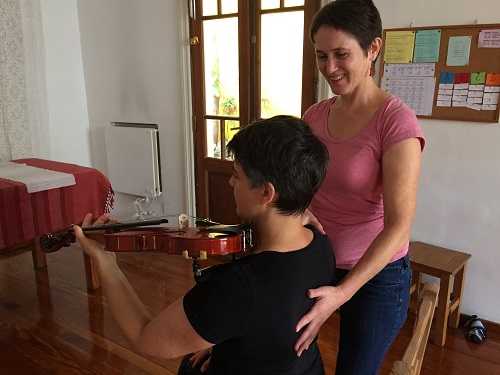At a recent DiscoverEase in Movement workshop for musicians, I was asked what do I do when I have to sit and play my violin for a long time in the same position so my back doesn’t hurt. Many of us, whether we’re musicians or not, find ourselves stuck in positions for an extended period of time in order to do something – or to not do something! – and that usually results in stiffness and pain.
At the time I think I gave a brief answer about allowing my head to balance on top of my spine, but I’d like to expand on that!
The first thing I do in order to deal with extended periods of relative stillness (sitting working at the computer, playing my violin, standing to wash dishes, sitting to watch a movie) is this: I have a regular, daily practice of finding ease in my self that helps me coordinate and allow ease in my body in those challenging moments, which we occasionally find ourselves in. (I use the word “ease” instead of “relaxation” because when we relax, often what we are really doing is “collapsing.” Relaxing is of course important, but being relaxed like a boiled noodle doesn’t help us to play an instrument or get something done.) This Alexander Technique practice of finding ease and coordination involves first and foremost: constructive rest. I can’t say enough about constructive rest!
Here’s how you do it: find a comfortable, quiet place where you can lie on the floor. (If you can’t get down and up, a bed will do, but a firm surface is best.) Place some books or magazines under your head (something relatively firm) so that your head doesn’t fall back and down, compressing your neck, but that your chin isn’t pushed into your chest, either. Bend your knees and place your feet as close to your bottom as is comfortable at a distance that helps you to keep your knees up with minimal effort. Allow your self to stop, and enjoy resting in this position for AT LEAST 5 minutes a day. If you can, 15 minutes is even better! As you lie there, notice ease in some part of your self and invite that ease to spread to the rest of you, particularly where your head and spine meet. You might be tempted to fall asleep in this position, which is fine, but using it to notice your self and be awake will give you greater benefits!
The second thing I do is when I play my violin or sit at the computer for a long time, I consciously work on my self, not just whatever it is outside my self that I am doing. I bring awareness of my inner coordination of head and spine to the activity I’m doing and invite ease in my body before, during and after, particularly in the head-spine area. It might sound hard, and yes, it does take practice, and yes, the touch communication of an Alexander Technique teacher helps tremendously to develop that skill. But the benefits are worth it and last a lifetime.
The third thing I do is remember where the support for my arms comes from. Both typing at the computer and playing the violin (and washing dishes, too, for that matter) involve using the arms, and the way we use our arms often creates an extra load for our backs, triggering pain or discomfort. I remember that my support comes from my spine and that my arms are part of my back. This helps me to free up my arms so they move more freely without weighing me down.
The other thing I do that the Alexander Technique has helped me with is to allow movement. That takes many forms. It may be very subtle movement of my body in the position I am in, it may be bigger movement in a coordinated way that keeps my spine lengthening instead of compressing, and it may be making the decision to get up and move. We all find ourselves in situations where we “have to” do something. One thing I’ve learned is that I don’t “have to” do anything. Everything is a choice. Every choice has its consequences. I can choose to be in a way that will result in stiffness and pain, or I can choose to do what I need to do to take care of my self.
This doesn’t mean that I never get stiff or that I never feel a twinge in my back. But if it happens, the Alexander Technique provides me with the tools I need to notice and to release unnecessary tensions, invite ease and return to an equilibrium.
So that’s the long answer!
If you’d like to do an online constructive rest session, write me at info@discoverease.how to schedule. I’m providing a gift of a free session to the first 3 people who contact me about it!
To update you on what I’m up to these days, I recently held an Alexander Technique for Strings Players workshop and I am beginning a new three-class course for strings players this Saturday in Buenos Aires.
If you want to learn more, you can read past articles here, subscribe to my newsletter to receive tips, articles and information about Alexander Technique classes, join the Mind-Body Freedom & Balance with Alexander Technique group in Facebook or write me to reserve an online class.


Recent Comments